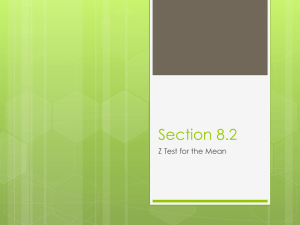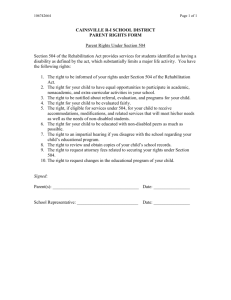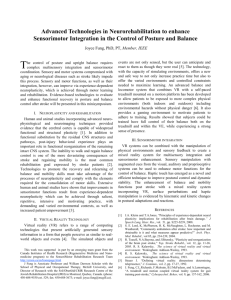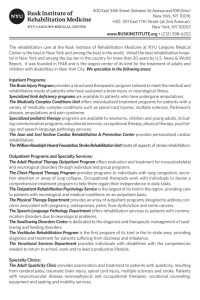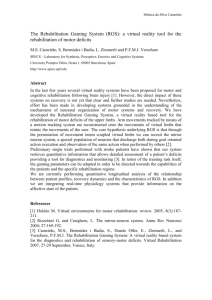Here - M-ITI
advertisement
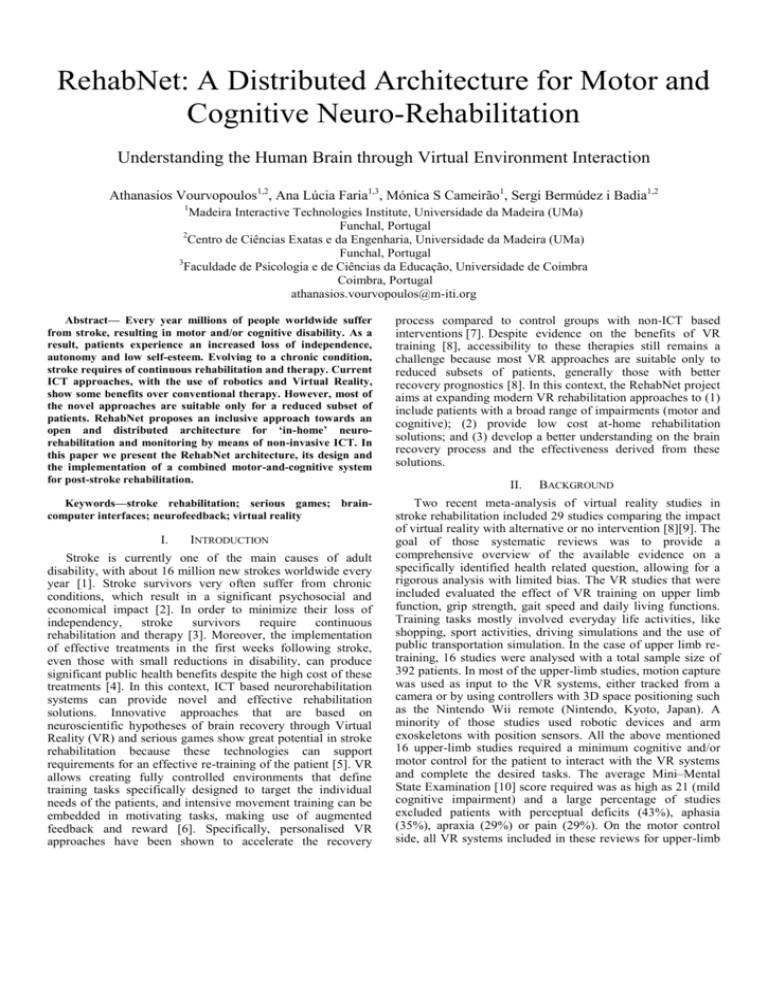
RehabNet: A Distributed Architecture for Motor and Cognitive Neuro-Rehabilitation Understanding the Human Brain through Virtual Environment Interaction Athanasios Vourvopoulos1,2, Ana Lúcia Faria1,3, Mónica S Cameirão1, Sergi Bermúdez i Badia1,2 1 Madeira Interactive Technologies Institute, Universidade da Madeira (UMa) Funchal, Portugal 2 Centro de Ciências Exatas e da Engenharia, Universidade da Madeira (UMa) Funchal, Portugal 3 Faculdade de Psicologia e de Ciências da Educação, Universidade de Coimbra Coimbra, Portugal athanasios.vourvopoulos@m-iti.org Abstract— Every year millions of people worldwide suffer from stroke, resulting in motor and/or cognitive disability. As a result, patients experience an increased loss of independence, autonomy and low self-esteem. Evolving to a chronic condition, stroke requires of continuous rehabilitation and therapy. Current ICT approaches, with the use of robotics and Virtual Reality, show some benefits over conventional therapy. However, most of the novel approaches are suitable only for a reduced subset of patients. RehabNet proposes an inclusive approach towards an open and distributed architecture for ‘in-home’ neurorehabilitation and monitoring by means of non-invasive ICT. In this paper we present the RehabNet architecture, its design and the implementation of a combined motor-and-cognitive system for post-stroke rehabilitation. process compared to control groups with non-ICT based interventions [7]. Despite evidence on the benefits of VR training [8], accessibility to these therapies still remains a challenge because most VR approaches are suitable only to reduced subsets of patients, generally those with better recovery prognostics [8]. In this context, the RehabNet project aims at expanding modern VR rehabilitation approaches to (1) include patients with a broad range of impairments (motor and cognitive); (2) provide low cost at-home rehabilitation solutions; and (3) develop a better understanding on the brain recovery process and the effectiveness derived from these solutions. Keywords—stroke rehabilitation; serious games; braincomputer interfaces; neurofeedback; virtual reality Two recent meta-analysis of virtual reality studies in stroke rehabilitation included 29 studies comparing the impact of virtual reality with alternative or no intervention [8][9]. The goal of those systematic reviews was to provide a comprehensive overview of the available evidence on a specifically identified health related question, allowing for a rigorous analysis with limited bias. The VR studies that were included evaluated the effect of VR training on upper limb function, grip strength, gait speed and daily living functions. Training tasks mostly involved everyday life activities, like shopping, sport activities, driving simulations and the use of public transportation simulation. In the case of upper limb retraining, 16 studies were analysed with a total sample size of 392 patients. In most of the upper-limb studies, motion capture was used as input to the VR systems, either tracked from a camera or by using controllers with 3D space positioning such as the Nintendo Wii remote (Nintendo, Kyoto, Japan). A minority of those studies used robotic devices and arm exoskeletons with position sensors. All the above mentioned 16 upper-limb studies required a minimum cognitive and/or motor control for the patient to interact with the VR systems and complete the desired tasks. The average Mini–Mental State Examination [10] score required was as high as 21 (mild cognitive impairment) and a large percentage of studies excluded patients with perceptual deficits (43%), aphasia (35%), apraxia (29%) or pain (29%). On the motor control side, all VR systems included in these reviews for upper-limb I. INTRODUCTION Stroke is currently one of the main causes of adult disability, with about 16 million new strokes worldwide every year [1]. Stroke survivors very often suffer from chronic conditions, which result in a significant psychosocial and economical impact [2]. In order to minimize their loss of independency, stroke survivors require continuous rehabilitation and therapy [3]. Moreover, the implementation of effective treatments in the first weeks following stroke, even those with small reductions in disability, can produce significant public health benefits despite the high cost of these treatments [4]. In this context, ICT based neurorehabilitation systems can provide novel and effective rehabilitation solutions. Innovative approaches that are based on neuroscientific hypotheses of brain recovery through Virtual Reality (VR) and serious games show great potential in stroke rehabilitation because these technologies can support requirements for an effective re-training of the patient [5]. VR allows creating fully controlled environments that define training tasks specifically designed to target the individual needs of the patients, and intensive movement training can be embedded in motivating tasks, making use of augmented feedback and reward [6]. Specifically, personalised VR approaches have been shown to accelerate the recovery II. BACKGROUND training are based on the exploitation of active movement (movement initiated and controlled by the patient). According to the available information on the inclusion criteria, most of those studies targeted moderate-to-severe motor dysfunction (3.3 ≤ average Chedoke McMaster [11] ≤ 5.5; 11.8 ≤ average Fugl-Meyer Assessment (upper limb) [12] ≤ 40. Thus, these recent reviews indicate that current VR based interventions directly leave out patients exhibiting no active movement, and that most exclude patients with very low muscle strength, arm control, with spasticity or perceptual or cognitive dysfunction [8][9]. Consequently, patients with the worse prognostic cannot fully benefit from the novel VR based approaches for upper-limb rehabilitation because these are mainly directed towards limited subset of patients. Thus, even with a plethora of different VR rehabilitation systems an accessibility problem to therapies remains. On the other hand, more accessible approaches such as mental practice and neurofeedback have been shown to improve motor and cognitive task performance [13],[14]. Unfortunately, little is known about what brain activation patterns lead to successful functional recovery, and how to optimally use neurofeedback paradigms. Longitudinal mental training studies for stroke recovery are still very rare and difficult to implement [15] [16]. As consequence, the specific benefits of these approaches over conventional therapy need further investigation. III. REHABNET RehabNet aims at building neuroscience based interactive systems for stroke rehabilitation. In general terms, stroke is the problem we are called to solve; neuroscience is how we are moving towards a better understanding of the brain mechanisms for recovery; and interactive systems are the tools that we are developing to achieve it. A. Approach The RehabNet approach is based on three hierarchically organized layers: first to guarantee accessibility of patients to therapy; second to ensure patient compliance with therapy; and finally to validate the effectiveness of therapy (Fig. 1, approach column). The main function of the accessibility layer is to provide a broad access to rehabilitation training to the wider possible range of patients. For this purpose, a number of interface and assistive technologies have been integrated, namely, physiological signals - electroencephalography (EEG) and electro-myography (EMG) -, tracking of movement kinematics, a robotic orthosis device with adjustable movement assistance, as well as device independent standard interface protocols for compatibility and upgradeability of the system. Once access to therapy is granted, by the accessibility layer of RehabNet, compliance with therapy needs to be achieved. The compliance of the user with the allocated tasks and the level of engagement with the overall treatment process is a challenging aspect of rehabilitation. The compliance layer aims at maximizing adherence to treatment to maximize its Fig. 1 RehabNet Framework. From top to bottom: the requirements hierarchy is unfolded starting from the accessibility to rehabilitation tools; moving to compliance and adherence of the patient to the rehabilitation process; and finally the evaluation and validation of the effectiveness of the approach. From left to right: the level of abstraction is unfolded starting from the general approach to the problem, moving to the technology that implements the required elements, and ending with the concrete applications that satisfy the initial requirements. effect. In order to achieve it, we improve compliance by lowering the access threshold (using low-cost portable interface systems), facilitating its use by providing the rehabilitation content in the cloud, and using social and gaming elements to improve patient engagement. Finally, novel VR therapies need to be based on clinical guidelines and neuroscientific hypotheses of recovery. Thus, assessing the effectiveness of VR rehabilitation tools is a crucial stage for evaluating improvement in performance, the correctness of the rehabilitation approach, and validating the underlying neuroscientific hypotheses of recovery. This feedback mechanism enables us to adjust all the appropriate elements of VR training towards the direction of a successful rehabilitation path. It is at this layer that patients interact with motor and cognitive rehabilitation VR training games, while data gathering can help to further understand the recovery process. B. Technology Given the existence of novel low-cost portable technologies such as tracking or EEG systems, RehabNet embraces the use of such technology together with the latest research findings for effective stroke rehabilitation to provide simpler and portable in-home neuro-rehabilitation. Technology must offer low cost, off-the-shelf components for data acquisition; lowering the access threshold for patients with different prognostics; and targeting in-home rehabilitation. The RehabNet system architecture (Fig. 2) is built around five key concepts (Fig. 1, technology column): Fig. 2 The RehabNet system architecture consists of three main building blocks: Hardware for device support, Control Panel for data translation and emulation, and Web Content for accessing the rehabilitation tools. All blocks are interconnected in a client-server (open) architecture. 1) Acquisition: The acquisition of data from available hardware is supported natively for a basic range of devices including EEG (EPOC, Emotiv Systems, Australia), EMG (mpower 1000, Myomo, Boston, USA) and kinematic data (Kinect, Microsoft, Washington, USA). The device support is extended using a client/server architecture. UDP is used for communicating with mobile devices and tracking servers for continuous data tracking. Additionally, by making use of the Virtual-Reality Peripheral Network (VRPN) protocol [17] and Open Sound Control (OSC) protocol [18] we are enabled to integrate a large number of existing peripherals (trackers, button devices, haptic devices, analog inputs, sound, etc) and to extend the repository of Brain-Computer Interface (BCI) support through the “Open-Vibe platform” [19]. 2) Translation: For a meaningful interaction between the patient and the rehabilitation process, the acquired data must be filtered, cleaned from noise, translated (e.g. from spatial coordinates to limb movement) or classified (e.g. EEG event detection) based on pre-defined rules. The most important function of this layer is to unify the whole set of data that can be captured by the different supported devices (BCIs, tracking, smartphones, etc) into a common information and data format that can be later used by our rehabilitation applications. For instance, this layer is in charge of classifying EEG data into left or right hand movement and consequently emulating key presses or analogue tracking devices. Similarly, tracking devices like MS Kinect can also emulate button clicks and events based on kinematic parameters. Finally, orientation and acceleration data from smartphone devices can be used to emulate tracking device data. 3) Distributed Architecture: One of the goals of RehabNet is to provide rehabilitation tools that are accessible from everywhere, both geographically (cloud services) and technologically (platform independent). Thus, the system architecture is distributed for maximum flexibility and upgradability to specifically target in-home rehabilitation making use of technology already existing at home. The typical installation includes the available hardware (HW) based locally on the computer of the user. This HW can range from a simple keyboard to a BCI. If the local computer is equipped with HW other than a keyboard or a mouse, the user needs to execute the RehabNet control panel software for interfacing the HW with the rehabilitation tools (Fig. 2). Further, our VR rehabilitation software is accessible online through a standard web browser [20]. The use of web technologies allows patients and clinicians to have access from everywhere, and additionally eases the maintenance and upgradeability at a technical level. Finally, for achieving the best possible adherence, the rehabilitation content will be made available through a social platform for patients, clinicians and researchers that aims at enhancing the social dynamics, communication and monitoring of patients. 4) Interaction: The main concept is to employ a single interaction framework that allows the implementation of simultaneous motor-and-cognitive tasks, adaptive at both the motor and cognitive capabilities of the patients. In this context VR provides a proper framework for implementing clinical guidelines in a controlled environment such as intensive, goal oriented, personalized and iterative training with augmented feedback [5]. Re-training of lost function through neuroplasticity is a necessary element [21], and it has been shown that the visual perception of goal oriented actions activates the mirror neuron system (MNS) [22]. This represents a promising rehabilitation strategy to enhance recovery after stroke [23]. Finally, training tasks should be embedded into motivating gaming experiences as in our previous work [20] [24]. In order to enable any device supported by the control panel to interact with all training games without any modification of the system, we have defined that all interactions with the VR environment should be performed by controlling a virtual character that in turn interacts with the VR content. This approach requires the control panel to translate all sensor data into kinematic data to drive a virtual character. This approach is not only consistent with the above considerations for effective training and activation of MNS, but it also allows for a more intuitive interaction with the system using Natural User Interfaces (NUI) when available. Consequently, the interaction with the VR Environment is achieved through the limb visualization; acting as the endeffector of the acquired sensor data. Depending on the level of motor control of the user, different interfaces are used and configured for moving the virtual arms using inverse kinematics. In addition, the system can be tuned to each user by adjusting parameters such as the required physical range of motion or performance. 5) Monitoring: The performance assessment of the VR training games can help both clinicians and patients to get useful feedback on performance and to adjust training towards the correct rehabilitation goals. RehabNet allows collecting valuable multimodal data (movement kinematics, EEG, EMG, training events, performance data) for quatitative monitoring during rehabilitation, while providing insights for further investigation of the recovery process. Monitoring is therefore essential for developing a better understanding of the effectiveness of treatments as well as for identifying their behavioral and neural correlates. C. Implementation The developed toolbox for implementing and satisfying the aforementioned requirements is a software suite composed by a Control Panel (CP), a Social Network, and Training Games for combined motor and cognitive re-training (Fig. 2, implementation column). With the CP we will be able to define quantitatively the requirements for a successful PatientVR interaction in terms of interface and training paradigms. The role of the social network is threefold, working as: an experimental design setup for researchers, a monitoring platform for clinicians, and a social interaction network for patients. The games used for the functional re-training will be designed based on the outcome of the assessments using the CP data in an iterative manner for the best VR interaction possible. 1) RehabNet Control Panel (CP): RehabNet CP is implemented in Unity 3D (Unity Technologies, San Francisco, USA) and acts as a device router, bridging a large number of tracking devices and other hardware with the RehabNet Training Games that we want the patient to interact with (Fig. 3). RehabNet CP implements the communication protocols in a client/server architecture. Native device support for the Emotiv EPOC neuro-headset is intergrated for acquiring raw Fig. 3 RehabNet Control Panel for data acquisition, translation, and routing. EEG data, gyroscope data, facial expressions and Emotiv‟s Expressiv™, Cognitiv™ and Affectiv™ suite through Emotiv‟s SDK. Additionally, Microsoft Kinect is natively supported either by the Microsoft or OpenNI drivers. Supporting OpenNI drivers allows making use of other natural user interfaces with 3D sensing when Kinect is not available. The myoelectric orthosis mPower 1000 (Myomo Inc, Boston, USA) is supported, providing 2 EMG channels and adjustable levels of assistance. Extended device support is achieved via a custom UDP protocol used for bridging with an Android/iOS app running on smartphones (sending sensor data) and the Analysis and Tracking System (AnTS) [25]. VRPN and OSC protocols are supported for the connection with any device (e.g. Vicon‟s tracking, Nintendo Wii Remote, 5DT data gloves) or software supporting it (e.g. OpenViBE BCI software). RehabNet CP performs data filtering, smoothing, translation and emulation on these data. In addition, logging of synchronized data in XML format is configurable from all the acquisition devices as well as game events for offline analysis. Finally, the CP allows to preview the translated avatar movements from the sensors, allowing to re-adjust parameters in real-time. 2) RehabNet Social Network: A social network based on the Elgg open source project (www.elgg.org) is under development to bring together patients and clinicians to form a powerful cluster to boost the rehabilitation process and enhance the social dynamics of the group. Direct communication between the members and the exchange of information through the process creates an eco-system that could result in a decrease of the dropout levels and help patients to have a healthy competition and socialize. Such a social network is designed to host the RehabNet Training Games, provide a forum for discussion among patients, clinicians, and relatives, as well as a platform for colecting and analyzing patient data on performance and training compliance. Fig. 4. RehabNet Training Games. This motor-and-cognitive task consists on performing a cancellation test using a virtual representation of the paretic arm. 3) RehabNet Training Games: One motor-and-cognitive training game has been developed at this stage, and existing motor training systems have been made compatible with the RehabNet framework [20]. The current motor-and-cognitive training game consists of a VR version of a cancellation task (Toulouse-Piéron test) [26] that has been implemented by using a representation of the paretic arm for navigating and crossing out the symbols in one or two dimensions (depending on the level of motor control of the patient) (Fig. 4). The VR arm end-effector is controlled using the RehabNet CP applying inverse kinematics on data from a computer mouse, keyboard, MS Kinect, object tracking through AnTS, or accelerometer data from Android/iOS devices. The training game has a build-in calibration function that is able to compute the active range of motion of the patient, normalizing the motor effort required to the skill set of the patient. The game has been implemented also with the platform independent Unity3d game engine, which is browser based with full screen capability, and makes use of the unity web player. The game settings (handedness, movement speed, task time, input device, network client settings, calibration settings, score) can be saved (in the standalone versions) together with a unique patient profile. IV. PRELIMINARY ASSESSMENT In order to assess the technology of the proposed system a proof of concept study has been performed with three patients, 2 male and 1 female with age 52, 68 and 72 respectively. All patients had stroke in the left hemisphere of the brain with right-sided hemiparesis. The study took place in Dr. João Almada Hospital, which belongs to the Health Service of Madeira Autonomous Region in Portugal (SESARAM). The stroke patients were submitted to an experimental protocol to test the following conditions of the cancellation task: paper and pencil; keyboard; mouse; AnTS and; Kinect (Fig. 5). During the assessment, two computers were used. One running the VR cancelation test used by the patient and a second computer running the RehabNetCP used by the experimenters. In the beginning of each session an initial calibration took place in order to adjust the game based on the patients‟ range of motion (RoM). Following the calibration, the VR environment was initiated for the patient to interact. Data acquisition, filtering, logging and transmission were performed at the RehabNet CP. The patient was asked to use the affected arm for selecting the targets on screen. So far patients with high spasticity had better control by using a regular glove (color-tracked by AnTS) because hardware devices like mice are challenging to grab and control. Movement through colour tracking revealed more natural and without the constraints that other hardware devices might have. We also observed that when tracking the limbs with the Kinect at small distances from the sensor, especially with patients with a small range of motion, positional data can be very inaccurate creating frustration and undesired fatigue to the user. In the usability questionnaire, two participants reported a very positive feedback, saying that they felt immersed and would like to continue doing this type of therapy. The other participant was motor aphasic and also had some comprehension deficits, so he found the task difficult to understand. This caused him to fail most of the targets, and got frustrated and requested to stop, referring to not wanting to continue this type of therapy. Fig. 5. Patient interacting with the VR training using AnTS. Left: the CP and AnTS running on the experimenters PC for data acquisition, logging, filtering and transmission. Right: The patient with a colored glove for tracking, interacting with TPT-VR V. DISCUSSION AND CONCLUSION RehabNet explores the use of non-invasive ICT for neurorehabilitation post-stroke. Such methods receive increasing attention in the research community since they can offer a more effective and personalized treatment of the lesions of the central nervous system. Here we have presented the RehabNet inclusive approach towards rehabilitation, its system architecture, and its first implementation. These technological advances have a strong potential towards novel and low cost treatments, health promotion, and disease monitoring and prevention. At a community level, such eHealth applications support the development of personalized and person-centric care methods and services, making real the new healthcare paradigm of „home as care environment‟. Further, bringing in the social networking aspects into the rehabilitation can increase adherence to therapy as well as improve communication between clinicians and patients, and among patients, which reduces the levels of isolation and increases monitoring of stroke survivors. Currently, we are deploying the RehabNet system to perform a randomised controlled trial (RCT) to assess the impact of the motor-and-cognitive training component. In the future we plan to generalize the developed motor-andcognitive training paradigm by replacing the active movement component by a neurofeedback paradigm, in which EEG activity patterns correlated with functional recovery will be rewarded. This will bring the benefits of VR training closer to patients without active movement capabilities. ACKNOWLEDGMENT This work is supported by the RehabNet project Neuroscience Based Interactive Systems for Motor Rehabilitation - EC (303891 RehabNet FP7-PEOPLE-2011CIG) (http://neurorehabilitation.m-iti.org). REFERENCES [1] K. Strong, C. Mathers, and R. Bonita, “Preventing stroke: saving lives around the world,” The Lancet Neurology, vol. 6, no. 2, pp. 182–187, Feb. 2007. [2] C. Vincent, I. Deaudelin, L. Robichaud, J. Rousseau, C. Viscogliosi, L. R. Talbot, and J. Desrosiers, “Rehabilitation needs for older adults with stroke living at home: perceptions of four populations,” BMC Geriatrics, vol. 7, no. 1, p. 20, Aug. 2007. [3] S. J. Albert and J. Kesselring, “Neurorehabilitation of stroke,” J. Neurol., vol. 259, no. 5, pp. 817–832, May 2012. [4] G. P. Samsa, R. A. Reutter, G. Parmigiani, M. Ancukiewicz, P. Abrahamse, J. Lipscomb, and D. B. Matchar, “Performing cost-effectiveness analysis by integrating randomized trial data with a comprehensive decision model: application to treatment of acute ischemic stroke,” J Clin Epidemiol, vol. 52, no. 3, pp. 259–271, Mar. 1999. [5] M. S. Cameirão, S. Bermúdez, and P. Verschure, “Virtual reality based upper extremity rehabilitation following stroke: A review,” Journal of CyberTherapy & Rehabilitation, vol. 1, no. 1, pp. 63–74, 2008. [6] L. F. Lucca, “Virtual reality and motor rehabilitation of the upper limb after stroke: a generation of progress?,” J Rehabil Med, vol. 41, no. 12, pp. 1003–1100, Nov. 2009. [7] M. da Silva Cameirão, S. Bermúdez i Badia, E. Duarte, and P. F. M. J. Verschure, “Virtual reality based rehabilitation speeds up functional recovery of the upper extremities after stroke: A randomized controlled pilot study in the acute phase of stroke using the Rehabilitation Gaming System,” Restorative Neurology and Neuroscience, vol. 29, no. 5, pp. 287–298, Jan. 2011. [8] K. Laver, S. George, S. Thomas, J. E. Deutsch, and M. Crotty, “Cochrane review: virtual reality for stroke rehabilitation,” Eur J Phys Rehabil Med, vol. 48, no. 3, pp. 523–530, Sep. 2012. [9] G. G. Fluet and J. E. Deutsch, “Virtual Reality for Sensorimotor Rehabilitation Post-Stroke: The Promise and Current State of the Field,” Curr Phys Med Rehabil Rep, vol. 1, no. 1, pp. 9–20, Mar. 2013. [10] M. F. Folstein, S. E. Folstein, and P. R. McHugh, “„Mini-mental state‟. A practical method for grading the cognitive state of patients for the clinician,” J Psychiatr Res, vol. 12, no. 3, pp. 189–198, Nov. 1975. [11] L. Valach, S. Signer, A. Hartmeier, K. Hofer, and G. C. Steck, “ChedokeMcMaster stroke assessment and modified Barthel Index self-assessment in patients with vascular brain damage,” Int J Rehabil Res, vol. 26, no. 2, pp. 93– 99, Jun. 2003. [12] A. R. Fugl-Meyer, L. Jääskö, I. Leyman, S. Olsson, and S. Steglind, “The post-stroke hemiplegic patient. 1. a method for evaluation of physical performance,” Scand J Rehabil Med, vol. 7, no. 1, pp. 13–31, 1975. [13] S. Silvoni, A. Ramos-Murguialday, M. Cavinato, C. Volpato, G. Cisotto, A. Turolla, F. Piccione, and N. Birbaumer, “Brain-Computer Interface in Stroke: A Review of Progress,” Clin EEG Neurosci, vol. 42, no. 4, pp. 245– 252, Oct. 2011. [14] M. Grosse-Wentrup, D. Mattia, and K. Oweiss, “Using brain–computer interfaces to induce neural plasticity and restore function,” J. Neural Eng., vol. 8, no. 2, p. 025004, Apr. 2011. [15] E. Karbonik, D. D. Montgomery, W. J. Burns, T. Chronopoulos, T. A. Kuntz, and D. Sandrow, “Longitudinal AVS dominant frequency feedback following stroke: A three year case study,” Proceedings of the Association for Applied Psychophysiology and Biofeedback, vol. 32, pp. 45–48, 2000. [16] S. M. Braun, A. J. Beurskens, P. J. Borm, T. Schack, and D. T. Wade, “The effects of mental practice in stroke rehabilitation: a systematic review,” Arch Phys Med Rehabil, vol. 87, no. 6, pp. 842–852, Jun. 2006. [17] R. M. Taylor II, T. C. Hudson, A. Seeger, H. Weber, J. Juliano, and A. T. Helser, “VRPN: a device-independent, network-transparent VR peripheral system,” in Proceedings of the ACM symposium on Virtual reality software and technology, 2001, pp. 55–61. [18] M. Wright and A. Freed, “Open Sound Control: A New Protocol for Communicating with Sound Synthesizers,” in International Computer Music Conference, Thessaloniki, Hellas, 1997, pp. 101–104. [19] Y. Renard, F. Lotte, G. Gibert, M. Congedo, E. Maby, V. Delannoy, O. Bertrand, and A. Lécuyer, “OpenViBE: an open-source software platform to design, test, and use brain-computer interfaces in real and virtual environments,” Presence: teleoperators and virtual environments, vol. 19, no. 1, pp. 35–53, 2010. [20] S. Bermudez i Badia and M. S. Cameirao, “The Neurorehabilitation Training Toolkit (NTT): A Novel Worldwide Accessible Motor Training Approach for At-Home Rehabilitation after Stroke,” Stroke Research and Treatment, vol. 2012, Apr. 2012. [21] A. Pascual-Leone, C. Freitas, L. Oberman, J. C. Horvath, M. Halko, M. Eldaief, S. Bashir, M. Vernet, M. Shafi, B. Westover, A. M. VahabzadehHagh, and A. Rotenberg, “Characterizing brain cortical plasticity and network dynamics across the age-span in health and disease with TMS-EEG and TMSfMRI,” Brain Topogr, vol. 24, no. 3–4, pp. 302–315, Oct. 2011. [22] G. Rizzolatti and L. Craighero, “The Mirror-Neuron System,” Annual Review of Neuroscience, vol. 27, no. 1, pp. 169–192, 2004. [23] G. Rizzolatti, M. Fabbri-Destro, and L. Cattaneo, “Mirror neurons and their clinical relevance,” Nature Clinical Practice Neurology, vol. 5, no. 1, pp. 24–34, 2009. [24] M. S. Cameirão, S. B. I. Badia, E. D. Oller, and P. F. M. J. Verschure, “Neurorehabilitation using the virtual reality based Rehabilitation Gaming System: methodology, design, psychometrics, usability and validation,” J Neuroeng Rehabil, vol. 7, p. 48, 2010. [25] Z. Mathews, S. B. i Badia, and P. F. M. J. Verschure, “A Novel BrainBased Approach for Multi-Modal Multi-Target Tracking in a Mixed Reality Space,” in Proceedings of 4th INTUITION International Conference and Workshop on Virtual Reality, 2007. [26] E. Toulouse, H. Piéron, and A. C. Pando, T-P: Toulouse-Piéron:(prueba perceptiva y de atención): manual. Tea, 2004.

